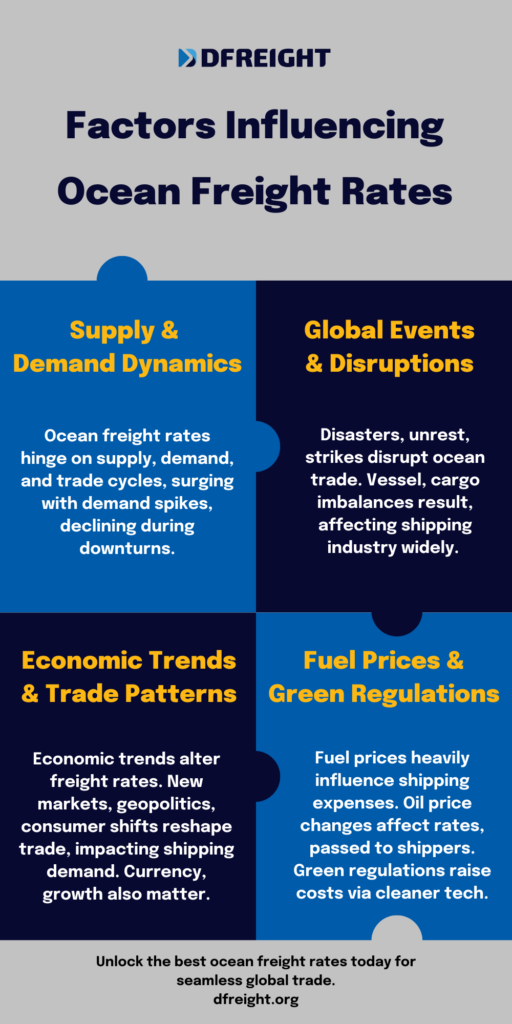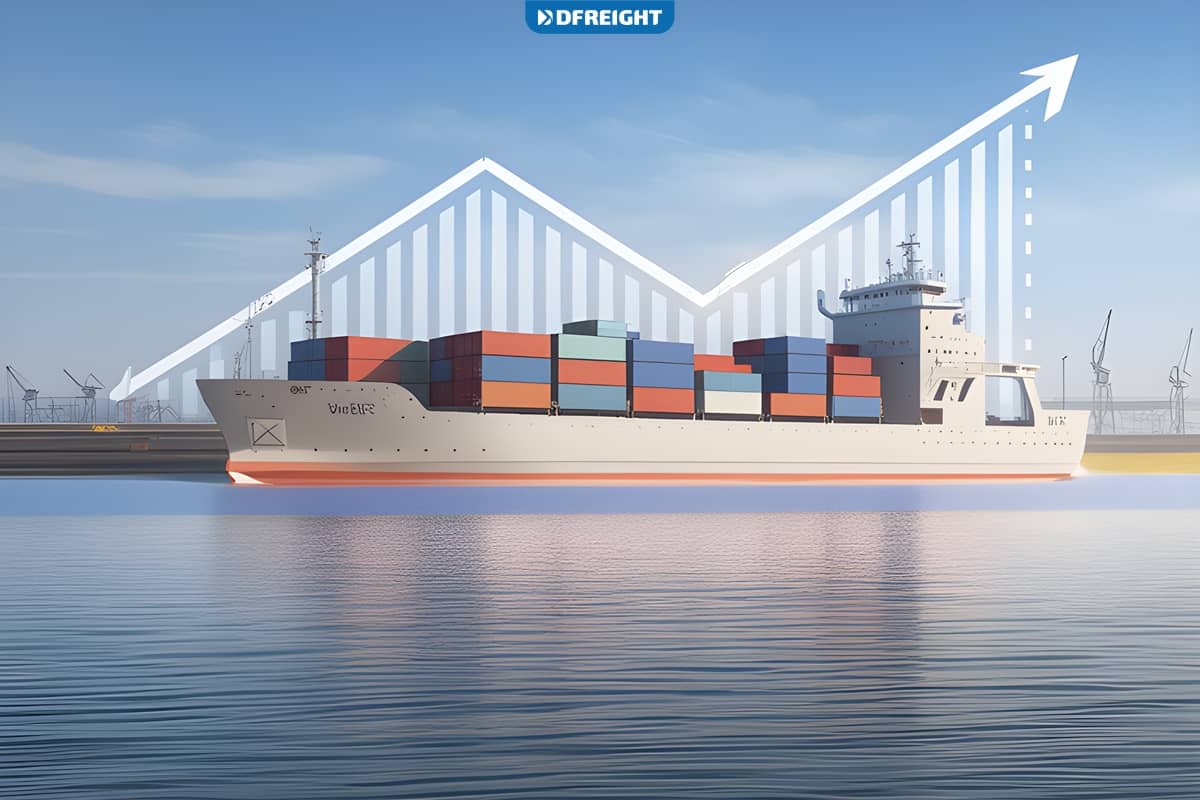In the intricate web of global trade and supply chains, the ebb and flow of ocean freight rates play a pivotal role. The cost of shipping goods across oceans isn’t just a matter of numbers; it reflects complex interactions between economic forces, technological advancements, geopolitical maneuvers, and unforeseen events. Recently, the world has been closely watching as ocean freight rates experienced unprecedented volatility, prompting businesses and industries to ponder a crucial question: Will ocean freight rates go down, or are we on the cusp of a new shipping paradigm?
Discover DFreight, your premier digital freight forwarder, revolutionizing shipping with cutting-edge technology. Unlock the best ocean freight rates today for seamless global trade.
This article delves into the multifaceted world of ocean freight rates, exploring the factors contributing to their fluctuations and the expert opinions that offer insights into the future. This exploration aims to provide a comprehensive understanding of the forces shaping the cost of maritime transport.
Table of Contents
Ocean Freight Rates vs Sea Freight Rates
Ocean freight rates and sea freight rates are terms often used interchangeably to refer to the cost of transporting goods via ships across the world’s waterways. Both terms describe the same concept, referring to the charges associated with shipping cargo by sea. These rates are determined by various factors, including the type of cargo, the shipping route, the distance traveled, the size of the vessel, market demand, fuel prices, and external economic and geopolitical factors. Whether called ocean freight rates or sea freight rates, they represent the financial aspect of maritime trade and play a crucial role in shaping global supply chains and international trade dynamics.
Factors Influencing Ocean Freight Rates
Like the tides, ocean freight rates rise and fall in response to many intricate factors that collectively shape the global shipping landscape. These factors create a delicate equilibrium, where even the slightest shift can trigger waves of change in the cost of transporting goods across the seas. Understanding these elements is essential for businesses, economists, and policymakers as they navigate international trade complexities. Here, we explore the key factors that influence ocean freight rates:

Supply and Demand Dynamics:
At the heart of ocean freight rates lies the age-old principle of supply and demand. When global trade is booming and cargo volumes surge, demand for vessel space increases, pushing rates upwards. Conversely, during economic downturns or lulls in trade, an oversupply of vessels relative to cargo can lead to rate declines. The balance between cargo supply and vessel capacity can shift rapidly due to various factors such as seasonal fluctuations, consumer demand changes, and disruptions in trade flows.
Fuel Prices and Environmental Regulations:
Fuel costs constitute a significant portion of the overall operating expenses for shipping companies. Fluctuations in oil prices can significantly impact freight rates, as higher fuel costs are often passed on to shippers. Moreover, the maritime industry is under increasing pressure to adhere to stricter environmental regulations, which can increase costs as companies invest in cleaner technologies and fuels.
Economic Trends and Trade Patterns:
Global economic trends and shifts in trade patterns have a profound impact on freight rates. The opening of new markets, the closing of trade corridors due to geopolitical tensions, or changes in consumer preferences can lead to alterations in trade routes and, consequently, in demand for shipping services. Additionally, different regions’ currency fluctuations and economic growth rates can influence trade volumes and shipping demand.
Global Events and Disruptions:
Natural disasters, political unrest, labor strikes, and other unexpected events can disrupt the smooth flow of goods across oceans. These disruptions can create imbalances in vessel availability and cargo supply, causing ripple effects throughout the shipping industry. The blockage of the Suez Canal in 2021 serves as a prime example, demonstrating how a single incident can lead to significant congestion, delays, and, subsequently, rate fluctuations.
Understanding these factors and their intricate interactions is crucial for predicting and managing fluctuations in ocean freight rates. Shipping companies, manufacturers, retailers, and consumers all bear the consequences of rate changes, making it essential to stay informed and adaptable in a dynamic global marketplace.
Technological Innovations and their Rate Implications
In the digital age, technological advancements are reshaping industries at an unprecedented pace, and the maritime sector is no exception. As the shipping industry embraces innovation, a wave of technological developments is influencing not only operational efficiency but also the dynamics of ocean freight rates. Here, we explore three critical technological innovations and their implications for shipping costs:
1.Digitalization and Smart Ports: Digital technologies have ushered in a new era of efficiency in maritime operations. From smart ports equipped with real-time data analytics to digital platforms that connect various stakeholders across the supply chain, these advancements reduce administrative bottlenecks, optimize resource allocation, and enhance overall transparency. As operations become smoother and more streamlined, the potential exists for reduced port turnaround times, more accurate scheduling, and minimized delays. Ultimately, these improvements can contribute to stabilized or even lower freight rates as operational costs are optimized.
2.Blockchain and Transparency: Blockchain technology is poised to revolutionize how information is shared, and transactions are conducted in the shipping industry. By providing an immutable and transparent ledger, blockchain enhances data accuracy, reduces paperwork, and minimizes the risk of fraud. This increased transparency can lead to more efficient customs processes, quicker cargo clearance, and better risk assessment, all of which have the potential to impact freight rates positively. As inefficiencies decrease and trust among stakeholders increases, costs related to disputes and delays may be mitigated, influencing rates in a favorable direction.
3.Autonomous Vessels: Though still in its infancy, the concept of autonomous vessels has the potential to reshape the entire maritime landscape. While fully autonomous ships are a vision for the future, the gradual integration of autonomous technologies, such as remote monitoring and navigation assistance, can reduce labor costs and enhance safety. As vessels become more independent, potential benefits include optimized route planning, fuel efficiency, and reduced human error. These improvements could have cascading effects on overall shipping costs, translating to potential savings that could be passed on to shippers.
While these technological innovations promise a positive impact on the maritime industry, their full-scale adoption and integration come with challenges and uncertainties. Regulatory frameworks, cybersecurity concerns, and the capital investment required for implementation are just a few factors that must be navigated. However, as the shipping industry continues to adapt and evolve, these innovations have the potential to play a significant role in shaping the future trajectory of ocean freight rates.
Government Policies and Trade Agreements
In the interconnected world of international trade, government policies and trade agreements wield immense power to shape ocean freight rates. From tariffs and trade wars to environmental regulations and occupation pacts, the decisions made at the governmental level have far-reaching implications for the shipping industry. Here, we delve into three critical aspects of government policies and trade agreements and their influence on ocean freight rates:
- Tariffs and Trade Wars: Tariffs and trade wars can send shockwaves through global supply chains, leading to abrupt shifts in shipping patterns and freight rates. When tariffs are imposed on imports or exports, they can disrupt established trade routes, redirecting cargo flows to regions with lower tariffs or creating congestion at specific ports. Trade wars, characterized by tit-for-tat tariff escalations, add uncertainty, causing businesses to rethink their sourcing strategies. The resulting fluctuations in demand and shipping routes can lead to volatility in freight rates as industries grapple with changing trade dynamics.
- Environmental Regulations: With increasing awareness of environmental concerns, governments are imposing stricter regulations on emissions and pollution in the shipping industry. While these measures are critical for the planet’s long-term sustainability, they also introduce additional costs for shipping companies. From using cleaner fuels to adopting energy-efficient technologies, compliance with environmental regulations can lead to higher operational expenses. The resulting cost burden could be passed on to shippers through increased freight rates as shipping companies strive to balance environmental responsibility and economic viability.
- Trade Agreements: Trade agreements play a pivotal role in shaping the global trade landscape. When countries come together to establish preferential trade terms, it can open up new avenues for commerce, potentially leading to increased trade volumes and altered shipping routes. Conversely, the failure of trade negotiations or the dissolution of trade agreements can create navigational roadblocks for businesses that had previously relied on specific trade preferences. These shifts can trigger fluctuations in demand for shipping services and, consequently, impact freight rates in affected regions.
The complex interplay between government policies, trade agreements, and ocean freight rates underscores the intricate dance between global economic forces and regulatory decisions. The uncertainty introduced by shifts in governmental stances and trade relationships can contribute to short-term fluctuations and long-term trends in shipping costs. As stakeholders across industries monitor these developments, the ability to adapt and strategize becomes paramount as businesses seek to navigate the changing tides of international trade.
Will Ocean Freight Rates Stabilize or Fluctuate?
The trajectory of ocean freight rates hinges on a complex interplay of various factors. While it’s challenging to predict with certainty, historical patterns suggest a mix of stabilization and fluctuations. Market dynamics, global economic conditions, geopolitical events, shipping capacity, fuel prices, and demand-supply imbalances all contribute to the ebb and flow of ocean freight rates. Short-term fluctuations might arise due to sudden disruptions or shifts in trade patterns, whereas capacity adjustments and improved forecasting mechanisms could influence long-term stabilization. As the shipping industry continues to adapt and innovate, a delicate balance between stabilization and periodic fluctuations will likely persist, driven by the intricate web of influences shaping the global maritime trade landscape.
Strategies for Businesses: Navigating Rate Uncertainties
In a world where ocean freight rates are subject to constant fluctuations, businesses must equip themselves with strategic tools to navigate the uncertainties of the shipping landscape. By adopting proactive measures, companies can manage the impact of rate changes and position themselves for resilience and growth. Here are three critical strategies for businesses to consider:
- Diversification of Suppliers and Trade Routes: One effective strategy to mitigate the impact of rate uncertainties is diversifying suppliers and trade routes. Relying heavily on a single supplier or trade route can leave businesses vulnerable to disruptions and rate spikes in specific regions. By diversifying sources of supply and exploring multiple trade routes, companies can distribute their risk more evenly. This approach helps ensure that a disruption in one area doesn’t cripple the entire supply chain. While diversification may entail slightly higher operational complexities, the benefits of reduced exposure to rate volatility can far outweigh the challenges.
- Contract Negotiation and Long-Term Agreements: Long-term agreements and favorable contract terms with shipping carriers can stabilize businesses in a volatile rate environment. Negotiating fixed or minimum volume commitments and longer-term contracts can help shield companies from sudden rate spikes. While these agreements may not eliminate rate fluctuations, they can provide a sense of predictability and cost control. However, balancing the benefits of fixed rates and the flexibility needed to adapt to changing market conditions is essential.
- Inventory Management: Inventory management plays a critical role in navigating rate uncertainties. Striking the right balance between cost efficiency and just-in-time (JIT) models is essential. While JIT strategies minimize storage costs and capital tied up in inventory, they can leave businesses exposed to delays or disruptions in the supply chain. Adopting a more flexible approach that combines JIT principles with a contingency buffer can provide a safety net against unexpected shipping delays. This approach allows businesses to maintain operational efficiency while safeguarding against disruptions.
By implementing these strategies, businesses can build a foundation of resilience that enables them to thrive in the face of rate uncertainties. The global shipping landscape is dynamic, and agility is paramount. Companies that are prepared to adapt, diversify, negotiate strategically, and manage inventory effectively are better positioned to weather the challenges of fluctuating ocean freight rates.
Ocean Freight Companies in the UAE
The UAE hosts a robust and dynamic maritime industry, with several prominent ocean freight companies playing a pivotal role in facilitating global trade. These companies offer a wide range of shipping and logistics services, including container transportation, bulk cargo shipping, and specialized freight solutions. Renowned companies have a strong presence in the UAE, leveraging the country’s strategic location as a central transshipment hub connecting Asia, Europe, Africa, and the Americas. With state-of-the-art port facilities, advanced technology adoption, and a commitment to innovation, ocean freight companies in the UAE contribute significantly to the country’s thriving economy and its position as a vital player in the international maritime landscape.
DFreight’s Revolutionary Ocean Freight Rates
DFreight sets sail with a groundbreaking approach to ocean freight rates, reshaping how businesses traverse the global trade. Our commitment to innovation and efficiency translates into providing you with revolutionary ocean freight rates that redefine industry standards. With a keen understanding of the dynamic market forces, DFreight leverages cutting-edge technology to secure the most competitive rates for your shipping needs. Whether you’re sending cargo across continents or exploring new markets, our transparent and cost-effective pricing ensures that your journey is financially advantageous and strategically positioned for success. Join us in revolutionizing your shipping experience and unlocking a world of unparalleled rates that put your business at the helm of global trade.

Conclusion
The ever-evolving world of ocean freight rates is a symphony of factors, from supply and demand dynamics to technological innovations, governmental policies, and global trade agreements. As businesses and industries grapple with whether these rates will stabilize or continue to fluctuate, one thing remains clear: the landscape is marked by opportunities and challenges. Navigating these uncertainties requires strategic foresight, adaptability, and a keen understanding of the forces at play. By embracing innovation, diversification, and proactive measures, businesses can weather the waves of rate volatility and carve out a path toward sustainable growth in the dynamic seas of international trade.
Are there any recent events that have caused fluctuations in ocean freight rates?
Yes, recent events like the Suez Canal blockage and the COVID-19 pandemic have led to significant disruptions in global shipping. These incidents have caused congestion, delays, and imbalances in supply and demand, which in turn have influenced fluctuations in ocean freight rates.
How can businesses prepare for rate uncertainties in the shipping industry?
Businesses can adopt strategic approaches to navigate rate uncertainties. Diversifying suppliers and routes, negotiating flexible contracts, and embracing adaptable inventory management strategies are key steps. By being proactive and staying agile, businesses can better position themselves to navigate the ever-changing landscape of ocean freight rates.
Can environmental regulations impact the cost of ocean freight rates?
Yes, environmental regulations aimed at reducing emissions and promoting sustainability can impact the cost structure of ocean freight rates. Shipping companies investing in cleaner technologies and complying with these regulations may incur additional expenses, which could potentially be passed on to shippers in the form of higher freight rates.
Is it possible to predict the future of ocean freight rates based on historical trends?
While historical trends provide valuable insights, predicting the future of ocean freight rates is challenging due to the dynamic nature of the shipping industry. Historical data can offer patterns and cycles, but a range of factors, including technological advancements, geopolitical events, and unforeseen disruptions, can cause deviations from historical trends.
Is ocean freight subject to GST?
Ocean freight for international shipments is usually exempt from GST. However, this exemption can vary based on country-specific regulations and trade agreements.
Do I need to pay GST on other shipping-related charges?
Ancillary charges like customs clearance, handling fees, and local delivery might be subject to GST. Consult local authorities for accurate information.
Is there a prediction for a decrease in ocean freight rates?
Ocean freight rates can fluctuate due to various factors such as demand, capacity, fuel prices, and global economic conditions. While predictions can vary, it’s advisable to monitor industry trends and expert forecasts for insights into potential rate changes.
Why ocean freight rates increase?
Ocean freight rates can rise due to factors like high demand for shipping, limited vessel capacity, geopolitical events, fuel price surges, and port congestion. These elements create supply-demand imbalances, impacting shipping costs.














